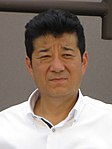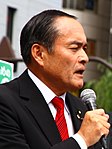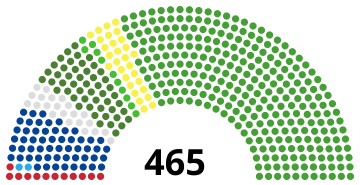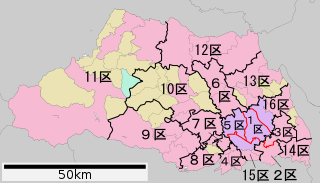| ||||||||||||||||||||||||||||||||||||||||||||||||||||||||||||||||||||||||||||||||||||||||||||||||||||||||||||||||||||||||||||||||||
All 465 seats to the House of Representatives of Japan 233 seats needed for a majority | ||||||||||||||||||||||||||||||||||||||||||||||||||||||||||||||||||||||||||||||||||||||||||||||||||||||||||||||||||||||||||||||||||
|---|---|---|---|---|---|---|---|---|---|---|---|---|---|---|---|---|---|---|---|---|---|---|---|---|---|---|---|---|---|---|---|---|---|---|---|---|---|---|---|---|---|---|---|---|---|---|---|---|---|---|---|---|---|---|---|---|---|---|---|---|---|---|---|---|---|---|---|---|---|---|---|---|---|---|---|---|---|---|---|---|---|---|---|---|---|---|---|---|---|---|---|---|---|---|---|---|---|---|---|---|---|---|---|---|---|---|---|---|---|---|---|---|---|---|---|---|---|---|---|---|---|---|---|---|---|---|---|---|---|---|
| Turnout | 53.68% ( | |||||||||||||||||||||||||||||||||||||||||||||||||||||||||||||||||||||||||||||||||||||||||||||||||||||||||||||||||||||||||||||||||
| ||||||||||||||||||||||||||||||||||||||||||||||||||||||||||||||||||||||||||||||||||||||||||||||||||||||||||||||||||||||||||||||||||
 Single-member district and PR block seats won by respective parties | ||||||||||||||||||||||||||||||||||||||||||||||||||||||||||||||||||||||||||||||||||||||||||||||||||||||||||||||||||||||||||||||||||
| ||||||||||||||||||||||||||||||||||||||||||||||||||||||||||||||||||||||||||||||||||||||||||||||||||||||||||||||||||||||||||||||||||
The 48th general election of members of the House of Representatives(Japanese:第48回衆議院議員総選挙 Hepburn:dai-yonjūhachikai Shūgiin giin sōsenkyo) took place on 22 October 2017. Voting took place in all Representatives constituencies of Japan – 289 single-member districts and eleven proportional blocks – in order to appoint all 465 members (down from 475) of the House of Representatives, the lower house of the then 707-member bicameral National Diet of Japan. Incumbent Prime Minister Shinzō Abe's governing coalition of the Liberal Democratic Party (LDP) and Komeito retained their seats in light of what was perceived as weak opposition, winning his fourth term in office and holding on to the two-thirds supermajority in order to revise the war-renouncing Article 9 of the Japanese Constitution. [1]
Japanese is an East Asian language spoken by about 128 million people, primarily in Japan, where it is the national language. It is a member of the Japonic language family, and its relation to other languages, such as Korean, is debated. Japanese has been grouped with language families such as Ainu, Austroasiatic, and the now-discredited Altaic, but none of these proposals has gained widespread acceptance.
Hepburn romanization is a system for the romanization of Japanese that uses the Latin alphabet to write the Japanese language. It is used by most foreigners learning to spell Japanese in the Latin alphabet and by the Japanese for romanizing personal names, geographical locations, and other information such as train tables, road signs, and official communications with foreign countries. Largely based on English writing conventions, consonants closely correspond to the English pronunciation and vowels approximate the Italian pronunciation.
A lower house is one of two chambers of a bicameral legislature, the other chamber being the upper house.
Contents
- Background
- Contesting parties and candidates
- Ruling coalition
- Koike's coalition
- Pacifist coalition
- Other parties
- Gender representation
- Opinion polling
- Voting intention (PR blocks)
- Voting intention (districts)
- Party approval
- Preferred prime minister
- Preferred outcome
- Cabinet approval / disapproval ratings
- Results
- Notable defeats
- Post-election
- Reactions and analysis
- Investiture vote
- See also
- Notes
- References
The snap election was called in the midst of the North Korea missile threat and with the largest opposition party, the Democratic Party, in disarray. Just hours before Abe's announcement of the snap election on 25 September, Governor of Tokyo Yuriko Koike launched a new conservative reformist party Kibō no Tō, the Party of Hope, which was seen as a viable alternative to the ruling coalition. It soon led to the dissolution of the Democratic Party and its party members defecting to the Kibō no Tō. However, the liberal wing of the Democratic Party, whose members Koike refused to nominate, formed the Constitutional Democratic Party of Japan (CDP) led by Yukio Edano, splitting the opposition in half. [2] The election turned into a three-way contest as the CDP joined with the Japanese Communist Party and Social Democratic Party on a common platform opposing the constitutional revision. While Kibō no Tō fell short of expectation, the CDP surged in the polls in the last days before the election and beat Kibō no Tō to emerge as first among the opposition parties. [3]
The Democratic Party, abbreviated as DP, was a political party in Japan. It was the largest opposition political party in Japan from 2016 until its marginalization in the House of Representatives in 2017. The party was founded on 27 March 2016 from the merger of the Democratic Party of Japan and the Japan Innovation Party. The majority of the party split on 28 September 2017, before the 2017 general election, with many its members contesting the election as candidates for the Party of Hope, Constitutional Democratic Party of Japan or as party members without nomination. On 7 May 2018 the DP merged with the Party of Hope to form the Democratic Party for the People.

Yuriko Koike is a Japanese politician who currently serves as the governor of Tokyo. She was a member of the House of Representatives of Japan from 1993 to 2016, and was previously the Minister of Defense in the cabinet of Prime Minister Shinzō Abe, but resigned in August 2007 after only 54 days in office. On 31 July 2016, Koike was elected Governor of Tokyo, the city's first female governor.
Kibō no Tō(希望の党, Party of Hope) is a conservative political party in Japan founded by Tokyo Governor Yuriko Koike. Governor Koike formed the party just hours before Prime Minister Shinzō Abe declared an early 2017 general election. The party's ideology is mainly conservative.
Despite being disrupted by Typhoon Lan, the election saw a slight increase in turnout rate of 53.68 percent but still was the second lowest in postwar Japan. The lowest ever turnout was recorded in 2014. [4] It was also the first election after the voting age was lowered from 20 to 18. [5] Abe also became the first Prime Minister to win three consecutive general elections since 1953 and the first LDP leader to do that. He is also set to be the longest serving Prime Minister if he finishes his full term of four years. [6]

Typhoon Lan, known in the Philippines as Typhoon Paolo, was the third-most intense tropical cyclone worldwide in 2017. A very large storm, Lan was the twenty-first tropical storm and ninth typhoon of the annual typhoon season. It originated from a tropical disturbance that the United States Naval Research Laboratory had begun tracking near Chuuk on October 11. Slowly consolidating, it developed into a tropical storm on October 15, and intensified into a typhoon on October 17. It expanded in size and turned northward on October 18, although the typhoon struggled to intensify for two days. On October 20, Lan grew into a very large typhoon and rapidly intensified, due to favorable conditions, with a large well-defined eye, reaching peak intensity as a "super typhoon" with 1-minute sustained winds of 250 km/h (155 mph) – a high-end Category 4-equivalent storm – late on the same day. Afterwards, encroaching dry air and shear caused the cyclone to begin weakening and turn extratropical, before it struck Japan on October 23 as a weaker typhoon. Later that day, it became fully extratropical before it was absorbed by a larger storm shortly afterwards.

























